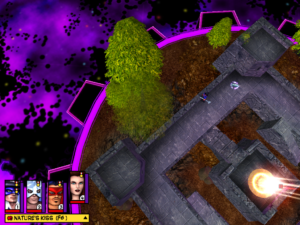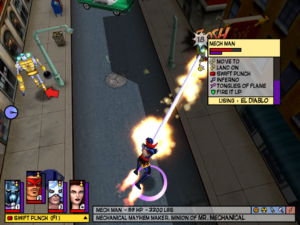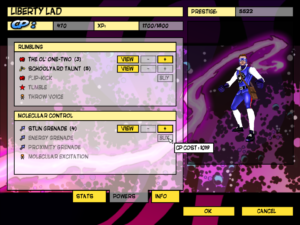WarioWare: Wario
WarioWare, Inc. is divided into a series of levels, each with its own set of microgames and its own host character who supposedly authored that section and also needs your help to get through the situation depicted in the level’s intro and epilogue. There’s some serious confusion of levels going on there; it’s as if Deus Ex started off with a cutscene of Warren Spector begging for the player’s help at defeating the secret organization pursuing him. No, that’s not quite right. That suggests a connection between the frame and the content. It’s more like Deus Ex starting with Waren Spector playing baseball at a company picnic, and every time you complete a mission, you get a cutscene of him hitting a home run.
The first and last levels are hosted by Wario himself. Because I’m primarily a PC gamer, this is the first significant exposure I’ve had to the character. I know of him, certainly. I was aware that he was a sort of evil twin to Mario, but I didn’t really know the details. Having seen him in action, I’d describe him not so much evil as somewhere between rotten and naughty, misbehaving like a little kid. He’s explicitly described as “sneaky” and “greedy”, and makes no bones about it, apparently considering those good qualities, because they’re his qualities and everything about him is by definition awesome. Which is also why most of the microgames on his own levels are about him. So I’d add “conceited” to the list, as well as “denigrating others”: he cheerfully tosses barbs at the player along the lines of “Huh? You beat that level? You?!?”
Come to think of it, he’s a lot like Strong Bad.
Also like Strong Bad, he comes off as childish partly because of his eagerness for characteristics that seem manly to him, like riding a motorcycle and punching at punching bags. Mario also has a sort of weird mix of adult and childlike traits, but they harmonize a lot better there, and seem to hit something of a sweet spot for acceptability by an American audience (unlike some Nintendo characters). Wario comes off like a grotesque caricature of this, exaggerated like a Mad Magazine parody. “No need to satirize us”, Nintendo seems to be saying, “We’ll satirize ourselves!” Since this is Wario’s game, it’s his world now, and it’s much more urban than the Mushroom Kingdom, more random and full of pointless conflict. The most innocent-looking of the hosts is pursued by police cars for speeding, and evades them by dropping banana peels in their path, making them skid and crash. They’re not bad guys, they’re just doing their job.
So, given this grotesque, childish, selfish, greedy, sneaky, antihero of a character, what role does he play in the game’s story? Why, that of game publisher, of course! His scheme is to get all these people, his supposed “friends”, to develop games for him, and then abscond with all of the profits himself. I can’t help but see this as reflecting the designers’ personal experience, and I’m a little surprised that Nintendo executives thought it acceptable — perhaps they didn’t understand what it was saying? Or perhaps from their perspective it looked more like a dig at little independent game companies trying to cash in on fields pioneered by others. Who knows.
 Comments(2)
Comments(2)

